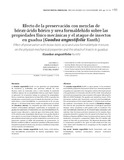Mostrar el registro sencillo del ítem
Efecto de la preservación con mezclas de bórax-ácido bórico y urea formaldehido sobre las propiedades físico mecánicas y el ataque de insectos en guadua (Guadua angustifolia Kunth)
| dc.rights.license | http://creativecommons.org/licenses/by-nc-sa/3.0/ve/ | |
| dc.contributor.author | Peña V.Luis | |
| dc.contributor.author | Burgos F., Amarilis | |
| dc.contributor.author | González Flores, Aura Marina | |
| dc.contributor.author | Valero, Styles W. | |
| dc.date.accessioned | 2010-06-02T21:32:28Z | |
| dc.date.available | 2010-06-02T21:32:28Z | |
| dc.date.issued | 2009-12-31 | |
| dc.identifier.issn | 0556-6606 | |
| dc.identifier.uri | http://www.saber.ula.ve/handle/123456789/31127 | |
| dc.description.abstract | La Guadua angustifolia Kunth es una gramínea con propiedades de resistencia y flexibilidad, que permiten utilizarla en usos diversos, tanto en Venezuela como a nivel mundial. Se pretende modificar algunas de sus propiedades internas, para lograr mejorar su aplicación. En el presente trabajo se evaluaron las propiedades físicas y mecánicas, siguiendo las normas DIN y ASTM. La guadua fue tratada para su preservación por el método de inmersión con bóraxácido bórico y urea formaldehído. La concentración al 2% en peso relación 1:1 de bórax-ácido bórico resultó ser óptima para el control del Dinoderus minutus. Se comprobó que dicha mezcla también erradicó enfermedades biológicas superficiales, al compararla con guadua sin tratamiento. El tratamiento con urea formaldehído al 2%, reportó mayor absorción y retención que el de bórax-ácido bórico al 2%; además estas propiedades disminuyen en la guadua desde la zona apical a la zona basal. El Módulo de Ruptura (MOR) en flexión para probetas preservadas por ambos tratamientos, aumentó en una proporción superior al doble del presentado sin preservación. La Resistencia Máxima (RM) en compresión paralela a la fibra para ambos tratamientos presentó valores muy cercanos y el doble al compararlas con las muestras sin tratamiento. | es_VE |
| dc.language.iso | es | es_VE |
| dc.publisher | SABER ULA | es_VE |
| dc.rights | info:eu-repo/semantics/openAccess | |
| dc.subject | Guadua Angustifolia Kunth | es_VE |
| dc.subject | Bórax | es_VE |
| dc.subject | Ácido bórico | es_VE |
| dc.subject | Úrea formaldehído | es_VE |
| dc.subject | Preservación de bambú | es_VE |
| dc.subject | Propiedades físicomecánicas | es_VE |
| dc.title | Efecto de la preservación con mezclas de bórax-ácido bórico y urea formaldehido sobre las propiedades físico mecánicas y el ataque de insectos en guadua (Guadua angustifolia Kunth) | es_VE |
| dc.title.alternative | Effect of preservation with borax-boric acid and urea formaldehyde mixtures on the physical- mechanical properties and the attack of insects in guadua (Guadua angustifolia Kunth) | es_VE |
| dc.type | info:eu-repo/semantics/article | |
| dc.description.abstract1 | The Guadua angustifolia Kunth is a grass species. It has resistance and flexibility properties that permit varied uses. Internal properties of guadua are expected to be changed to achieve the improvement of its applications, in Venezuela and all over the world. Some physical and mechanical properties were assessed in this paper, following the DIN and ASTM Standards. The guadua was treated by means of the immersion method with: borax-boric acid and urea-formaldehyde. The concentration at 2% in weight relation 1:1 of borax-boric acid was the optimum concentration for the control of Dinoderus minutus. This mixture also provided the elimination of biological superficial diseases, when comparing it with guadua with no treatment. The urea formaldehyde treatment at 2% showed higher absorption and retention than the borax-acid boric treatment at 2%; besides, these properties diminish in guadua from the apical to the basal zone. The Modulus of Rupture (MOR) in flexion for preserved test pieces, in both treatments, increased in a proportion higher than the double with respect to that with no preservation. The Maximum Resistance (MR) in compression parallel to the grain for both treatments had very close values and it doubled when comparing it to the samples with no treatment. | es_VE |
| dc.description.colacion | 135-144 | es_VE |
| dc.description.email | are@ula.ve | es_VE |
| dc.description.email | gonzaura@ula.ve | es_VE |
| dc.description.email | styles@ula.ve | es_VE |
| dc.description.frecuencia | semestral | |
| dc.publisher.pais | Venezuela | es_VE |
| dc.subject.facultad | Facultad de Ciencias Forestales y Ambientales | es_VE |
| dc.subject.keywords | Guadua angustifolia Kunth | es_VE |
| dc.subject.keywords | Borax-boric acid | es_VE |
| dc.subject.keywords | Urea formaldehyde | es_VE |
| dc.subject.keywords | Bamboo preservation | es_VE |
| dc.subject.keywords | Physical mechanical properties | es_VE |
| dc.subject.publicacionelectronica | Revista Forestal Venezolana | |
| dc.subject.seccion | Revista Forestal Venezolana: Artículos | es_VE |
| dc.subject.thematiccategory | Geografía | es_VE |
| dc.subject.thematiccategory | Medio Ambiente | es_VE |
| dc.subject.tipo | Revistas | es_VE |
| dc.type.media | Texto | es_VE |
Ficheros en el ítem
Este ítem aparece en la(s) siguiente(s) colección(ones)
-
Revista Forestal Venezolana - Número 053 - Vol 002
Julio - Diciembre 2009


